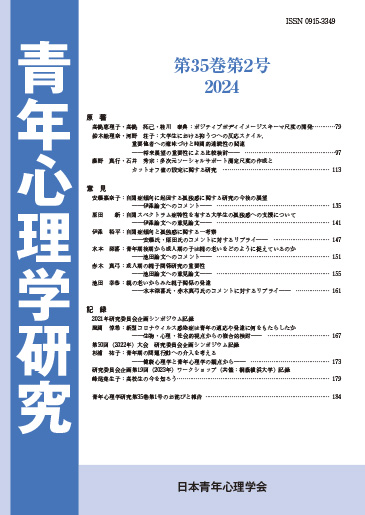Current issue
Displaying 1-12 of 12 articles from this issue
- |<
- <
- 1
- >
- >|
Articles
-
Article type: research-article
2024 Volume 35 Issue 2 Pages 79-95
Published: April 08, 2024
Released on J-STAGE: May 15, 2024
Download PDF (1386K) -
Article type: research-article
2024 Volume 35 Issue 2 Pages 97-112
Published: April 08, 2024
Released on J-STAGE: May 15, 2024
Download PDF (1484K) -
Article type: research-article
2024 Volume 35 Issue 2 Pages 113-133
Published: April 08, 2024
Released on J-STAGE: May 15, 2024
Download PDF (1387K)
Comments
-
Article type: reply
2024 Volume 35 Issue 2 Pages 135-140
Published: April 08, 2024
Released on J-STAGE: May 15, 2024
Download PDF (1181K) -
Article type: reply
2024 Volume 35 Issue 2 Pages 141-145
Published: April 08, 2024
Released on J-STAGE: May 15, 2024
Download PDF (1180K) -
Article type: reply
2024 Volume 35 Issue 2 Pages 147-150
Published: April 08, 2024
Released on J-STAGE: May 15, 2024
Download PDF (1244K) -
Article type: reply
2024 Volume 35 Issue 2 Pages 151-154
Published: April 08, 2024
Released on J-STAGE: May 15, 2024
Download PDF (1172K) -
Article type: reply
2024 Volume 35 Issue 2 Pages 155-159
Published: April 08, 2024
Released on J-STAGE: May 15, 2024
Download PDF (1176K) -
Article type: reply
2024 Volume 35 Issue 2 Pages 161-165
Published: April 08, 2024
Released on J-STAGE: May 15, 2024
Download PDF (1250K)
Records
-
Article type: meeting-report
2024 Volume 35 Issue 2 Pages 167-172
Published: April 08, 2024
Released on J-STAGE: May 15, 2024
Download PDF (1256K) -
Article type: meeting-report
2024 Volume 35 Issue 2 Pages 173-178
Published: April 08, 2024
Released on J-STAGE: May 15, 2024
Download PDF (1249K) -
Article type: meeting-report
2024 Volume 35 Issue 2 Pages 179-183
Published: April 08, 2024
Released on J-STAGE: May 15, 2024
Download PDF (1232K)
- |<
- <
- 1
- >
- >|
